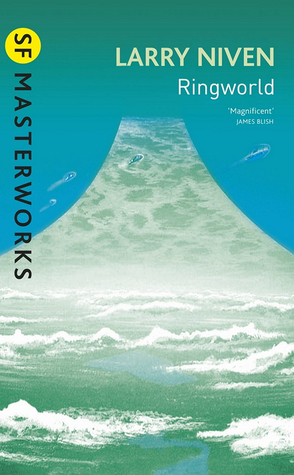Book review: Ringworld by Larry Niven

I first read Ringworld many years ago, not long after it was published. Returning to it now, I was curious as to how well it would hold up and how much of it I would remember.
First, the remembering. The answer was, a surprising amount. The Ringworld itself, obviously. For those who don’t know, the Ringworld is a slice of a Dyson Sphere, a ring around a star with miles high mountains on each rim to hold the atmosphere in place. It’s an extraordinary idea, expanding on scale in an exponential fashion: the Ringworld is big, really, really big.
However, I do remember being disappointed that we never find out anything about the Ringworld’s creators, nor what happened to them, and in that too my memory held up. I’ve not read the sequel but in many ways the book is a stand alone story and it leaves a lot of questions unanswered.
Then, the Puppeteers. They are one of Niven’s most enjoyable creations. A race of congenitally cowardly aliens who manipulate the other races of the galaxy to ensure their own survival.
Speaking of manipulated races, the Kzin, the warrior felines who send a representative along on the expedition to the Ringworld are great too. But it’s not just the Kzin: the Puppeteers have manipulated mankind too, breeding people for luck.
Which brings us to Teela Brown, the luckiest woman in the world. The product of generations of lucky winners in the lottery of life, she’s an interesting creation: so lucky that she’s untouched by pain and can follow her whims wherever they please. But Niven, wittingly or not, posits a higher purpose to Teela Brown’s luck than just fortune: it becomes a force that wants what is good for her, not in the utilitarian sense of the maximum of pleasure and the minimum of pain, but a good that points towards a Platonic idea of the best Teela Brown. A person who is properly human, the Platonic Form of Teela Brown. So her luck brings her to a place where she can become who she is supposed to be. I’m not sure if this was the point Niven was making but it is the consequence of the story’s logic.
Then, there are the sunflowers. Oh, boy, I remembered those. Unending fields of reflective sunflowers that focus the sun’s energy on any threats, burning it to a crisp, like holding the point focus of a magnifying glass over an ant. I think it was the sunflowers that I remember best.
As to how the story held up: surprisingly well. Of course, the attitudes are different, but it would be strange if they were not: fifty years have passed. Some reviewers would seem to prefer that nothing had changed – or that they are incapable of appreciating another time in its own timeframe.
0 Comments